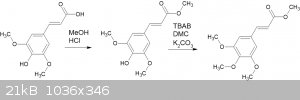
DrDevice - 26-5-2021 at 04:32
Sinapic acid (or sinapinic acid) is a hydroxycinnamic acid prevalent in mustard plant byproduct. It can be esterified as per carboxylic acids, and
o-methylated as per phenols. Of interest is the ease of o-methylation using DMC and a phase transfer catalyst.

Esterification of sinapic acid
6.9g sinapic acid @224.21 = 30.8mmol, is suspended in 30ml MeOH.
Prepare methanolic HCL by adding 1.2 equiv (2.9g) of acetyl chloride dropwise to 40ml ice-cold MeOH.
The methanolic HCL is added slowly to the sinapic acid suspension, then stirred for 11 hours at 40 - 45C (It may take much less time than this; I just
let it run overnight). The ester is obvious in the reaction mix as crystalline material.
TLC at 11 hrs (1:1 EtOAc:hexane) showed no trace of the source acid.
100 ml water is added to the reaction mixture and chilled in the fridge for a few hours. The raw methyl ester is filtered off, then dissolved in
EtOAc. The solution is washed with 30ml 5% sodium bicarbonate solution, organic fraction washed with brine, then dried with MgSO4, and solvent
evaporated.
The ester is re-crystalized from 1:1 EtOH:water, for a total yield of 5.7g, or 78%. MP ~ 86C (I can't find a literature MP value)
O-methylation of methyl sinapate using DMC and PTC
If you have access to a modest pressure vessel, dimethyl carbonate and tetrabutylammonium bromide, o-methylation can be done avoiding the use of (eg)
dimethyl sulfate or methyl iodide.
5.65g methyl sinapate (23.4mmol), 40ml DMC, 0.1 equiv of TBAB (0.76g), and 1.5 equiv K2CO3 are combined in a 100ml glass flask
capable of sustaining 140C at elevated pressure. (I don't know just how much pressure is involved here, but I've had no failures to date. I do however
use a "blast shield" around my oil bath in case of catastrophic failure. I use a flask manufactured by "Ace" glass)
A stir bar is added and the flask flushed with nitrogen prior to screwing down the lid. The flask is immersed in an oil bath at 140C and contents
magnetically stirred.
After 8 hrs, the flask is removed from the oil bath and allowed to cool to RT. The lid is cautiously unscrewed and CO2 comes out of
solution.
TLC (1:3 EtOAc:hexane) shows a spot at Rf = 0.52, compared to 0.24 for the source methyl sinapate. No trace of the methyl sinapate is seen in the
reaction product.
The solids are filtered and washed thoroughly with acetone, and the filtrates combined and evaporated. The yellow material is re-crystalized twice
from 1:1 EtOH:water to yield a fluffy slightly crystaline white solid, methyl 3,4,5-trimethoxycinnamate, MP 93 - 94C, lit. 99 - 100C). Yield exactly
5.00g, 19.8mmol, 85%, so quite a good result!
So I guess there are still some impurities in there - or maybe cis- / trans- isomers?? Nothing shows up on the TLC though with the eluents I have
tried.
I've tried the process with other hydroxycinnamic acids: o-coumaric acid works fine, but ferulic acid is offering some "random" results I haven't got
to the bottom of yet.
Next stop - amidation. I'm getting some encouraging results with @kmno4's"put it in a bottle with ammonia solution and leave it for several weeks"
approach. Also playing with reduction of the double bond with NiCl2/Zn.
[Edited on 26-5-2021 by DrDevice]
njl - 26-5-2021 at 11:33
Really refreshing stuff! Would love to hear more about the other acids you tried, and the experiments you have planned.
karlos³ - 26-5-2021 at 11:48
Sounds cool.
Have you bought or isolated those acids, or synthesised them yourself?
DrDevice - 28-5-2021 at 19:00
I bought the sinapic acid. I did try to do an extraction of sinapoyl choline from mustard cake, the remnants of mustard seed after oil extraction, but
with a singular lack of success.
I'll write up the ferulic acid experiment separately - mostly based around o-methylation of ethyl ferulate. I am getting two distinct products, one of
which is a very low melting point solid, which doesn't line up with any known melting point I can find of any ferulic acid derivative.
The amide is interesting and results are encouraging. Not ready to "publish" my results yet, but I'm fairly confident I have synthesized
"3,4,5-trimethoxycinnamide" - melting point is consistent. Interestingly, this is also known as "cintriamide", and seems to have some history as an
anti-psychotic drug. Can't find much in the literature about its therapeutic use, however.
I'm also planning on some work in reducing the double bond using Ni/ZnCl2. Watch this space.
Dr.Bob - 30-5-2021 at 06:58
If you have the pressure tube, then you could put the ester and some source of ammonia (ideally a solution in isopropanol) in it, then heat it to 120
or more for a gew hours, that will often displace a methyl ester.
